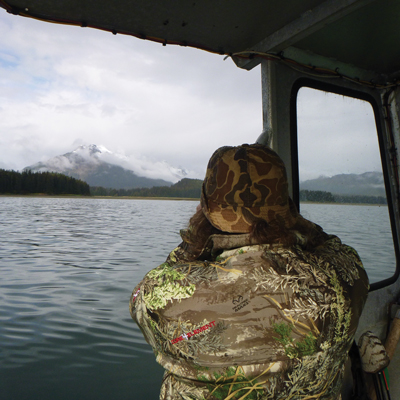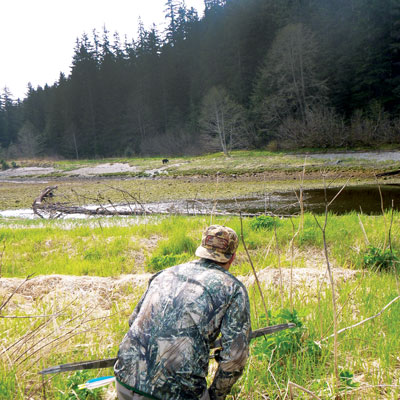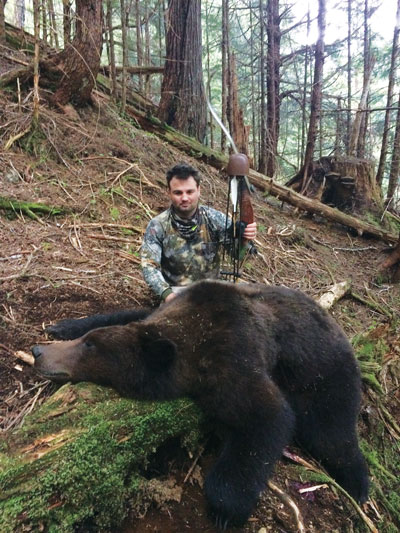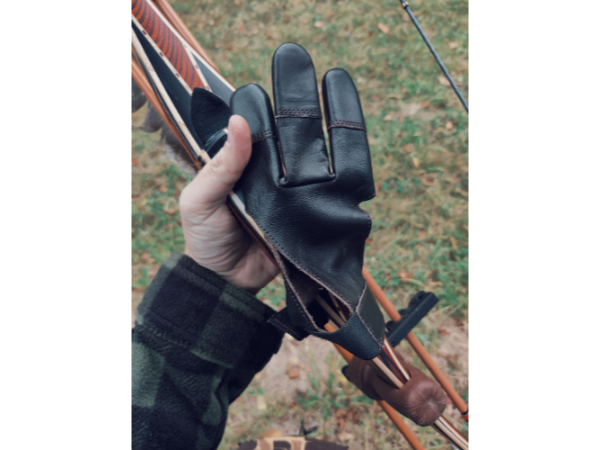Nervously I switched the safety on top of the double barrel 12-gauge on and off, following a footstep behind Rosey. We had closed a quarter-mile distance on an unsuspecting coastal brown bear, from where we anchored our aluminum skiff and canoed to shore. We trotted when the bear looked down and imitated washed up beach logs when he swung his head up to look for the next fresh green shoots of spring salad. Now we hunkered behind a patch of isolated shore pine, the only cover, less than a football field away from the brownie. He appeared to be headed right by us in bow range, but in typical bear fashion he turned in the opposite direction. A gauntlet of bubble wrap popping kelp lay out over a bed of grey slate in the tidal area between us and the bear. Before leaving the shelter of the scraggly pine, I gently broke open the shotgun’s action to ensure two brass insurance policies were in place, closed it, and flipped off the safety. Sensing my itchy finger, Rosey nocked an arrow and matter-of-factly whispered, “If this turns bad, make sure I’m out of the way before you shoot.” Then he slithered out from the shade and into the rare May sunshine in Southeast Alaska.
While sitting around a woodstove during the Sitka blacktail deer rut with John “Rosey” Roseland, the subject turned to brown bear hunts, Southeast Alaska’s ABC Islands (Admiralty, Baranof, and Chichagof), and their high brown bear densities. Alaska residents are allowed to harvest one brown bear in most of these units every four years. The Schafer I was shooting had recently been run over, after I forgot I’d leaned it up against a buddy’s truck as he drove off. Contemplating which bow to hunt with while Dave Windauer was fixing the Goodyear tracks on my limbs, Rosey dropped off a bow duly named the “Bear Getter” for me to take on our brown bear hunt. The Bear Getter was a takedown Schafer Silvertip Recurve, 78# at 28”, gifted to Rosey by Paul Schafer thirty years ago. The bow had some trademark Rosey artwork—rattle-can green camo strokes sprayed on the riser with tree bark camo moleskin glued inside.
Having seen the picture albums and many critters it had laid to rest, I had a knot in my gut thinking about stringing up the Bear Getter to shoot it, let alone subjecting it to the abuse of Southeast Alaska’s beaches and brush. “What if I run it over or a limb delaminates, a bear chews on it after eating me, or worse I put a miss in it?” I protested, pushing the bow back to Rosey and feeling a little uneasy about the responsibility that comes along with a bow with such a legendary history.
“It’s not wall art, it’s a bow, it’s meant to be shot! If it breaks, throw it in the fireplace!” Rosey scoffed as I reluctantly took hold of the Bear Getter’s riser. With a slight adjustment to the nock height, I found out that thirty years hadn’t taken the edge off the limbs. It drew silky smooth and sent my 700-grain arrows into orbit. To my wife’s delight, I hung the Bear Getter up in our bedroom and fell asleep dreaming about all the adventures it had seen.

Rosey glassing the shoreline for bear.
With the May sun rising early in Southeast Alaska, Rosey and I were up early the first morning of the hunt with the hum of our borrowed skiff cutting across the icy sea-green straits of the Alexander Archipelago. Back in a bay along the tide flat, an Ursus arctos middendorffi, was foraging for cockles, butter clams, crabs, beach grass, and mussels. With an outgoing tide, I dropped Rosey off on a sandy beach with bows, shotgun, and backpacks, before motoring out to a safe anchorage several hundred yards from the tide line. Out of sight from the bear, I dropped the anchor and 60’ of chain over the bow, as quietly as can be done, into the 50-degree water. One major oversight was the “sit on top” plastic kayak that came along with the boat to get to shore. It was designed for a 50-pound kid in a backyard pool at best, and after a dozen wobbly paddle strokes toward the beach, it left me dog paddling back to the boat towing the kid’s toy behind me. With renewed faith in my balance and half a splintered carbon kayak paddle, I pointed the bow of the four-foot plastic bath toy toward the beach and didn’t breathe until I stepped out onto the barnacle encrusted shore. Needless to say, the bear was long gone by then.
After changing into a dry shirt and downing a shot of lukewarm mid-morning coffee, the outgoing tide switched just in time to catch another blonde bruin walking down the beach with his head up and purpose in his step. The contour of the sandy beach offered stealthy travel. I followed close behind Rosey with my hands clutched on the forearm and grip of the double barrel, much like following a determined setter on fast running pheasants through switch grass. Before we collided, a swirling breeze must have flushed Blondie back into the dense hemlock cover. After motoring into a few more bays for a look-see, the Yamaha started stalling out and the wind chopped up white caps in the strait. We limped back to the dock keeping the 4-stroke Yamaha under 2000 RPM. As the distant village grew closer and the waves increased, the low throttle and deep plow of the aluminum hull powered toward safe harbor so Rosey could try his hand at some shade tree mechanic work.
We left the Mickey Mouse kayak on the dock and traded a case of beer for the use of a leaky canoe. Rosey paddled it a full 100 feet down the dock before it took on several gallons of salty green water, but it was better than what we had so we lashed it to the front of the skiff. We put some blind faith in our mechanic work early the next morning, and made a two hour run to a new bay to stay put for a week. Brilliant clear mornings and glassy waters can make up for all the sideways rain one experiences in Southeast Alaska, and this morning was one of those rare beauties.
Rosey and I debated cruising beaches on the way which provided a lot of bear seeing opportunities, but we were more interested in the shooting opportunities. If we could see one walking down an old logging road before he saw us, we might get a shot opportunity. In theory I agreed, however my eye wandering toward the backs of luscious, green, grass filled coves while easing off the throttle told a different story. Rosey kept catching my wandering eye and pointing his index finger toward an area with abundant old closed-off logging roads where we hoped to set up an ambush.

The author putting a stalk on bear feeding on the tidal flats.
While toting gear from the boat to camp, I spotted a dark chocolate bear chowing grass on the other side of a river that dumped into a nearby estuary. Rosey still had his longbow in the boat, and I had the Bear Getter in hand, so there was no discussion on who was up for the stalk. While trying to decide how best to cross the estuary, the wind swirled proving not every brown bear in the country wants to charge. When my scent hit him it might as well have been with a load of #6 shot, because Chocolate tucked tail and ran. He wasn’t one of the nine or ten footers that I had visualized crawling up on for months, but he was all brown and all bear. He crashed off leaving the scrubby hemlock and salal swaying in his wake.
After securing our gear and the boat, we went walking down logging roads shaded by red alder, cedars, spruce, and hemlock, glassing up into an occasional clear cut. The roadbeds were dry and noisy, and we contemplated taking our boots off and walking in stocking feet. With the slight breeze in our face, we squinted and tip-toed around each corner, hoping to catch a bear with its head down eating a skunk cabbage. Two draft horse sized piles of steaming brown bear scat and a smoking hot track the size of both my size 10 Xtra Tuff boots side by side, told me Rosey either really wanted to get off the water or he was onto something. Checking out several overgrown spur roads, we continued with the breeze in our face.
After the logging road climbed into the muskegs and the abundance of luscious grass decreased we conceded the hunt, turning to let the breeze hit our backs and the sun sink over the mountain. Walking back, the temptation of the yellow skunk cabbage flowers against the dull muskeg became too much, and we shot our way back toward camp. Seeing the Bear Getter back in action fished stories out of Rosey’s album of memories—everything from Montana elk hunts to Alaska Peninsula caribou, a couple of Iowa red squirrels, and of course several bear hunts. The Bear Getter had seen more country than Lewis and Clark, and here it was again shish-kabobing elusive western skunk cabbages (or at least scaring the hell out of them!).
The 12-gauge had been on my back all afternoon, as I insisted that Rosey take the next stalk after my bust earlier in the day. Needing to dig something out of my pack, I handed the double barrel to Rosey. By the time I got my pack on, he already had it slung over his shoulder ready to head the last bit to camp. Then a dark shadow bolted off into the shadows. While looking up into the dense hemlock patch in front of us, we went into predator mode. In a fast whisper, Rosey and I yammered back and forth about which one of us would nock an arrow and lead the way.
Rosey shrugged it off, claiming there wasn’t a snowball’s chance in hell that bear was going to stick around after seeing us or catching our scent in the swirling wind. “I’ve got the shotgun so go ahead, but he’s probably long gone,” he said. I’d like to say that he held me at gun point and made me nock an arrow and stomp up to where we last saw the bear. However, there was a four-blade Zwickey Eskimo sliding out of my quiver by the time he finished his sentence. Knowing I was committed, Rosey grinned and contradicted himself: “Get ready, because sometimes they’ll stand back in the cover and just watch you!”
Besides the occasional shriek of a raven, the woods were silent as I crept on the outsoles of my Xtra Tuffs. Rosey followed with the 12-gauge. Then we heard a crash in the brush and the sound of heavy footsteps but couldn’t see anything. I had it engrained in my head to be looking for cubs, to avoid shooting a sow. We crept closer to an opening in the vegetation. Rosey was right. There was the brown bear, perched up on a knob under the dark canopy of hemlocks, looking down at us. Checking for cubs and seeing none, I drew the Bear Getter back as my right middle finger found the familiar corner of my mouth. The bear was slightly quartered toward and directly above us on a steep incline. Tree limbs in front of me blocked the crease behind his front shoulder, but the branches slowly came out of view as I bent at the waist.
When the arrow hit the crease I was looking at, he crow-hopped off the knob and ran up the hill 20 yards before quickly hitting the deck behind a rotting log. “Looked good,” whispered Rosey, holding the scatter gun ready for action while looking over my shoulder with an easy grin on his face. We could have been a couple kids throwing snowballs at cars instead of arrows at brown bears. Rosey suggested I sneak up for another shot just in case. I had to set the Bear Getter out in front of me to get enough leverage on the nearby branches to start the initial ascent to the bear lying not 50 yards away. My foot slipped, sending a rock down the hill toward Rosey, who was climbing right behind me. The noise must have alerted the bear, because he stood up behind the log and did a forward gainer down the hill toward us. By the time I scrambled to get my footing and the bow back in my hand, it was over.

Unlike all the other bears the author encountered, this bruin’s curiosity got the best of him.
Within an hour we had taken a few pictures, loaded our packs, and started walking back to camp. If it wasn’t Choc-o-late from earlier in the day, it could have been a carbon copy. As the dark cast over the forest canopy, we walked past trails depressed in the duff and rock that bears have traversed down for millennia, dragging nutrient rich salmon carcasses to the ancient trees to eat them and fuel their growth. It was sobering to think about removing a piece of the chain, as well as the pure luck involved in the encounter. The previous bear seemed as spooky as an Iowa whitetail after the shotgun season, and I couldn’t believe this one stood there long enough for the shot.
For the next several days, we slunk along the logging roads and creeks and around lakes, always an hour or two behind or ahead of fresh tracks and scat. Late one morning we decided to fire up the boat to charge the batteries and run the bilge. A couple of miles down the bay we spotted a two-tone bear, with blond shoulders and body and dark legs and chest. Motoring out of sight and leaving plenty of margin of error for the outgoing tide, I killed the motor and threw the anchor as Rosey steadied the leaky canoe next to the gunnel.
With Rosey’s arrow nocked, the distance to the bear slowly feeding in the opposite direction began to shrink. Rosey tip-toed through the maze of bubble wrap kelp, stopping as the feeding bear raised his head. There was zero cover to hide behind and getting back into the trees would have been too noisy and time consuming. I quickly realized the pressure in these situations was on the gunner, because I would only be called into duty if things went to hell in a hurry. Visualizing how to side step Rosey to get a clear shot at a charging bear replayed over and over in my head as we slowly made it into bow range.
We stopped at 30 yards. Fortunately for an undetected stalk, the bear’s butt was directly facing us. Unfortunately, it didn’t leave anything to shoot at. Rosey kept on moving closer as the bear slowly fed away. After a few more steps the bear stopped, well within the range at which Rosey had been killing skunk cabbage all week. As the bear started to turn and open up a quartering away shot, Rosey brought his bow arm up with tension on the string. The bear must have noticed from the corner of his eye the two pieces of upright driftwood that hadn’t been behind him 30 seconds ago. I don’t recall seeing another animal in North America move so fast. A second before Rosey got to full draw, the bear was into the trees like a scalded dog—more proof that not every brown bear in the woods wants to eat you.
The bay was getting choppy with the tide ripping out against a strong incoming breeze, and I started to second guess how much anchor rope I had put out. Hot-footing it back down the beach, I kept muttering, “I can’t believe that just happened.” What I really meant was, “I can’t believe that just didn’t happen.” It was so close. I also couldn’t believe the excitement of being on the back-up end of a brown bear stalk. As the bow man, you’re focused on making the stalk and shot and for everything to go right. As the gunner, you’re readying yourself for everything that could go wrong. What was even more surprising is that I couldn’t decide which end I liked being on better. Regardless of the role, and regardless of what my wife thinks, chasing brown bears around is a lot of fun! Rosey just shrugged it off and said, “Let’s go find another one.”
While peering behind me to the stern man in the canoe paddling against the whitecaps back to the skiff, I reached another conclusion. Old bows are meant to go to the woods. They get run over, and lost, and spouses sell them for a fraction of their value at garage sales when we pass on. The dings, scratches, and rattle-can artwork tell the stories from tromping all over God’s green Earth believing the next opportunity lies right around the bend!
Matt Andersen lives on Prince of Wales Island, Alaska, with his wife and their two children. John Roseland is proud of his status as the World’s Oldest Hippie Bowhunter.







What a great yarn! I admire blokes who hunt like this. Could visualise the stalks, the tension and end result—good and not so good—of each one. Well done! And look after that Bear Getter.